 “I was the best man at the wedding. If I’m the best man, why is she marrying him?”
“I was the best man at the wedding. If I’m the best man, why is she marrying him?”- “The idea behind the tuxedo is the woman’s point of view that men are all the same; so we might as well dress them that way. That’s why a wedding is like the joining together of a beautiful, glowing bride and some guy. The tuxedo is a wedding safety device, created by women because they know that men are undependable. So in case the groom chickens out, everybody just takes one step over, and she marries the next guy.”
- “It’s amazing that the amount of news that happens in the world every day always just exactly fits the newspaper.”
- “Dogs are the leaders of the planet. If you see two life forms, one of them’s making a poop, the other one’s carrying it for him, who would you assume is in charge.”
- “There’s very little advice in men’s magazines, because men don’t think there’s a lot they don’t know. Women do. Women want to learn. Men think, “I know what I’m doing, just show me somebody naked.””
- “Sometimes the road less traveled is less traveled for a reason”
- “According to most studies, people’s number one fear is public speaking. Number two is death. Death is number two. Does that sound right? This means to the average person, if you go to a funeral, you’re better off in the casket than doing the eulogy.”
- “What is a date really, but a job interview that lasts all night? The only difference is that in not many job interviews is there a chance you’ll wind up naked.”
- “To me, a lawyer is basically the person that knows the rules of the country. We’re all throwing the dice, playing the game, moving our pieces around the board, but if there is a problem the lawyer is the only person who has read the inside of the top of the box.
- “Men want the same thing from their underwear that they want from women: a little bit of support, and a little bit of freedom.”
- “Men don’t care what’s on TV. They only care what else is on TV.”
- “I once had a leather jacket that got ruined in the rain. Why does moisture ruin leather? Aren’t cows outside a lot of the time? When it’s raining, do cows go up to the farmhouse, “Let us in! We’re all wearing leather! Open the door! We’re going to ruin the whole outfit here!””
Category: Hobbies and Pursuits
Standard Household Towel Sizes: Bath Towels, Wash Clothes
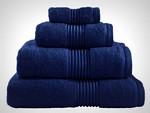 Department stores offer towel collections that come with a variety of sizes, knitting style, cotton quality, and personalization details to fit the space, budget and personal preferences of buyers. Common household towels are made from cotton, rayon, bamboo, non-woven fibers or other organic materials. Most homes use three types of towels for each person in the household: bath towels, hand towels, and wash towels.
Department stores offer towel collections that come with a variety of sizes, knitting style, cotton quality, and personalization details to fit the space, budget and personal preferences of buyers. Common household towels are made from cotton, rayon, bamboo, non-woven fibers or other organic materials. Most homes use three types of towels for each person in the household: bath towels, hand towels, and wash towels.
- Bath Towel: Size: 27 by 52 square inches (about 69 by 132 square centimeters.) The bath towel is the indispensable, do-it-all towel used for drying after bathing, showering or swimming.
- Bath Sheet: Size: 35 by 60 square inches (about 89 by 152 square centimeters.) Bigger and more indulgent that a standard bath towel, a bath sheet can provide more coverage after a shower or a bath.
- Hand Towel: Size: 16 by 30 square inches (about 41 by 76 square centimeters.) Hand towels are used for drying the hands after washing them.
.jpg) Wash Towel or Wash Cloth: Size: 13 by 13 square inches (about 33 by 33 square centimeters.) Wash towels are used both in and out of a shower or bath by wetting, applying soap to the towel, and then using the towel to apply the soap to wash the face, hands, and the rest of the body. The particular utility of a hand towel is in its increased abrasion that can remove dead skin cells more effectively than direct application of soap on the skin and manual rubbing. Also called wash towel, face cloth, flannel, and face-washer (in Australia.)
Wash Towel or Wash Cloth: Size: 13 by 13 square inches (about 33 by 33 square centimeters.) Wash towels are used both in and out of a shower or bath by wetting, applying soap to the towel, and then using the towel to apply the soap to wash the face, hands, and the rest of the body. The particular utility of a hand towel is in its increased abrasion that can remove dead skin cells more effectively than direct application of soap on the skin and manual rubbing. Also called wash towel, face cloth, flannel, and face-washer (in Australia.)- Fingertip Towel: Size: 11 by 18 square inches (about 28 by 46 square centimeters.) Fingertip towels are smaller than hand towels and placed in guest bathrooms at refined residences as a replacement for hand towels.
- Foot Towel or Tub Mat: Size: 27 by 52 square inches (about 69 by 132 square centimeters.) A foot towel or tub mat is a medium-size rectangular towel placed onto a bathroom floor to dry the feet for those coming out of a shower or a bath. Foot towels and tub mats are tightly woven and very absorbent. The foot towel or tub mat is usually a substitute for a floor rug, carpet, or bathroom mat. One of the difficulties with using a foot towel is that it might slip and slide around on tiled floors. Most foot towels cannot provide the friction and grip of a floor rug, carpet, or bathroom mat; hence, improved designs consist of an under-surface clutching design to improve grip.
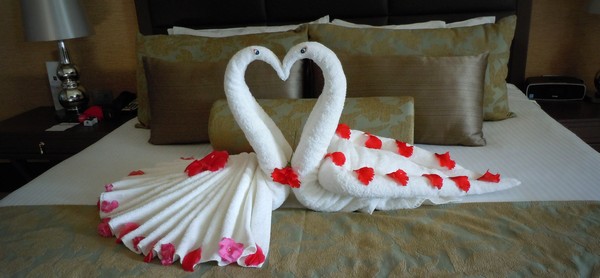
.jpg) Recommended Resources: ‘Towel Creations’ by Holland America Line. Carnival Cruises claims to have introduced considers towel animals as part of its trend-setting “Fun Ship” experience. Currently, Carnival Cruises, Holland America, Norwegian, Royal Caribbean, and Disney Cruise Line serve up towel creations to their guests. Each evening, as part of the turndown service, cabin attendants fold terry-cloth towels and washcloths into various shapes. These cruise lines also offer guidebooks filled with descriptive illustrations to help guests replicate these towel animal creations at home. Also recommended: ‘Carnival Towel Creations’ by Carnival Cruises.
Recommended Resources: ‘Towel Creations’ by Holland America Line. Carnival Cruises claims to have introduced considers towel animals as part of its trend-setting “Fun Ship” experience. Currently, Carnival Cruises, Holland America, Norwegian, Royal Caribbean, and Disney Cruise Line serve up towel creations to their guests. Each evening, as part of the turndown service, cabin attendants fold terry-cloth towels and washcloths into various shapes. These cruise lines also offer guidebooks filled with descriptive illustrations to help guests replicate these towel animal creations at home. Also recommended: ‘Carnival Towel Creations’ by Carnival Cruises.
Recipe: Make Basmati Rice the Traditional Way
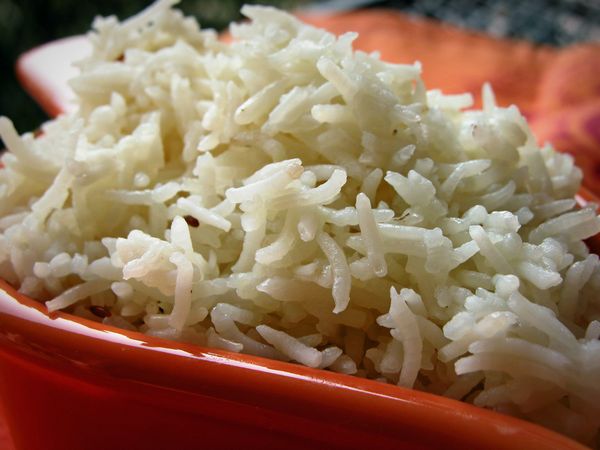
Arguably the most famous rice in the world, basmati rice is a variety of long grain rice renowned for its fragrance and delicate flavor. In Hindi, basmati literally means “queen of fragrance.” Characteristically, the grains of basmati rice are longer than usual forms of rice. The grains grow longer as they cook. They aren’t sticky and remain firm and separate.
The lyohe fertile plains in the Indian subcontinent have cultivated basmati rice since the dawn of civilization. The best basmati rice grows in the foothills of the Himalaya range of mountains in Northern India, where the rice crops are fed by the mineral-rich rivers sourced in the melting snow of the Himalaya mountains. The best of basmati rice, traditionally aged for several years before it is milled and sold, consists of lower moisture content and therefore rice cooks better.
Basmati Rice Recipe: Traditional Method
- Clean the rice. Soak it in water for five to seven minutes. Never soak Basmati for too long since the grains are softer than most varieties of rice and over soaking makes it soggy when you cook.
- Boil water first and then add the rice to it.
- Cook till the grains get tender. This generally does not take much time. You have to check repeatedly to make sure that the rice is not overcooked. Now, since I cook rice such that there is water to be drained, I have a specific measurement for water. But generally I pour enough to ensure that the rice is completely soaked and if the water gets less due to evaporation, I add some more so that it does not get sticky or dry.
- Drain the extra water. You can do this by letting the rice settle first at the bottom of the container and then drain as much water as you can on the top. There will be some water still remaining. Cover the container with a dish of the same size as the rim of the container and gradually pour out the rest of the water. Now, with the mouth covered with the dish/lid invert the container completely and let it rest on the kitchen slab near the sink for a while so that most of the water drains out and flows into the sink. (you don’t want a mess right! Also remember to be careful while draining the water. Hold the dish/lid with a cloth so that you don’t burn yourself.
- To ensure that the grains are completely separated add some cold (room temperature) water into the rice again and repeat step 4. I have found that this really helps and separates the grain.
I always cook rice by draining the extra water and thus the starch.
Best Budget Binoculars Your Money can Buy

What to Look for in Binoculars: the Essential Features and Guidelines
Whether you are considering buying a pair of binoculars for casual use during a cruise or upcoming travel or for more serious uses in bird gazing or stargazing, here are the essential features to consider when buying a pair of binoculars.
- Magnification and objective lens. The optics of binoculars are designated using two numbers, for e.g., 10×50. 10×50 means that a binocular offers 10 times magnification—distant objects appear ten times larger than they would without the binocular.—and consists of a 50mm objective lenses. For general use during casual travels, cruises, bird-watching, and nature observations, something in the range of 8×32, 8×42, 10×42 would be more than sufficient. For sporting events, 10×50, 12×50, 10×42, 8×32 are recommended. Astronomy users need better magnification and a wider field of view and might find 7×50, 10×50, 15×70, 20×90 configurations helpful.
- Ease on the eyes, especially if you wear glasses. Good quality binoculars offer a comfortable eye relief. Eye relief measures the allowable maximum distance between your eye and the eyepiece before the field of view starts to diminish. Greater the eye relief, smaller the image (think of a tunnel) through the eye piece. This can affect you if you wear glasses: you must hold the binoculars a little farther away from your eyes than somebody who doesn’t wear glasses. Buy binoculars with eye relief of 14mm or more.
- Light-weight, compact in size and the ability to fold and store.
- Water-resistant or waterproof design can be handy features for use during damp or humid conditions.
- Image stabilization technology to diminish the effects of shakes and vibrations caused by hand motion.
Note that good eye relief, waterproof designs and image stabilization technologies will be absent in budget binoculars.
Budget Binoculars that Offer Value for Money
Below are my top picks for binoculars that are inexpensive and yet offer great optics and range for the average user. Most of these binoculars feature built-in diopter adjustments which can help you adjust for differences in your vision from one eye to the other. Many of the mid-range consist of an antireflective coating to reduce glare and maintain optimal image quality.
Personally, I carry Bushnell Falcon 10 X 50mm binoculars on my travels and presented a Bushnell Powerview 10 X 25mm Compact Folding binoculars for my mother.
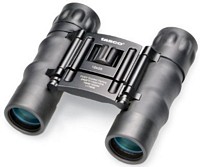 Tasco Essentials Binoculars (10 X 25mm, Start at $9) feature fold-down eyecups for use with eyeglasses and come with black rubber armoring. These are perfect for use during casual travels where carrying normal-sized and heavy binoculars might become very cumbersome and for use indoors. Users of the Tasco Essentials binoculars tend to be especially like the clear vision that can zoom on a bird’s from as far as 150 yards.
Tasco Essentials Binoculars (10 X 25mm, Start at $9) feature fold-down eyecups for use with eyeglasses and come with black rubber armoring. These are perfect for use during casual travels where carrying normal-sized and heavy binoculars might become very cumbersome and for use indoors. Users of the Tasco Essentials binoculars tend to be especially like the clear vision that can zoom on a bird’s from as far as 150 yards.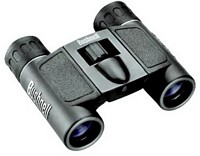 Bushnell Powerview Compact Folding Roof Prism Binoculars (10 X 25mm, Start at $12) are an excellent value. They are small and light and consist of extraordinarily sharp optics compared to the other low-end binoculars in its price range. The compact size of its design comes with a drawback though: to compensate for the short eye relief distance, users will have to roll down the eye cup. And for users who wear glasses, this can diminish the field of view. Great choice for children who tend to lose or break them more frequently than adults do.
Bushnell Powerview Compact Folding Roof Prism Binoculars (10 X 25mm, Start at $12) are an excellent value. They are small and light and consist of extraordinarily sharp optics compared to the other low-end binoculars in its price range. The compact size of its design comes with a drawback though: to compensate for the short eye relief distance, users will have to roll down the eye cup. And for users who wear glasses, this can diminish the field of view. Great choice for children who tend to lose or break them more frequently than adults do.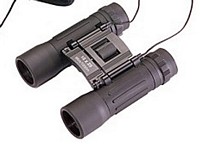 Coleman Binoculars (10 X 25mm, Start at $19) are well-made, compact in shape, and come with a belt-attachable carry case. When collapsed and fit in their case, they are just 2in X 3 in X 5 in. One drawback is that the Coleman consists of almost no eye relief. Therefore, expect long eyelashes to interfere with your view.
Coleman Binoculars (10 X 25mm, Start at $19) are well-made, compact in shape, and come with a belt-attachable carry case. When collapsed and fit in their case, they are just 2in X 3 in X 5 in. One drawback is that the Coleman consists of almost no eye relief. Therefore, expect long eyelashes to interfere with your view.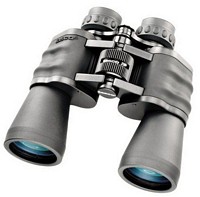 Tasco Essentials Zip Focus Binoculars (10 X 50mm, Start at $33) promises the most superior optics among binoculars that cost less than $100. They are lightweight, easy to hold, and offer first-rate optics. Those who use this model for stargazing can gaze at constellations with sharp optics and no reflection of any kind inside, even with urban lights outside. Birdwatchers will be amazed at the clarity and sharpness of the lens.
Tasco Essentials Zip Focus Binoculars (10 X 50mm, Start at $33) promises the most superior optics among binoculars that cost less than $100. They are lightweight, easy to hold, and offer first-rate optics. Those who use this model for stargazing can gaze at constellations with sharp optics and no reflection of any kind inside, even with urban lights outside. Birdwatchers will be amazed at the clarity and sharpness of the lens.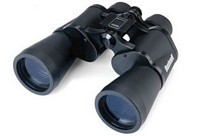 Bushnell Falcon Wide Angle Binoculars (10 X 50mm, Start at $34) are specially useful for people who have trouble focusing & adjusting binoculars, even to view objects that are 25 yards away. The lens caps on the eye pieces seem floppy and drop easily. The tilt focus (in addition to the knobs) can let an user change the focus without having to run a finger along a knob, shaking the view as it focuses. The quality of the strap and a bag are inadequate, but the binoculars are an excellent value for money.
Bushnell Falcon Wide Angle Binoculars (10 X 50mm, Start at $34) are specially useful for people who have trouble focusing & adjusting binoculars, even to view objects that are 25 yards away. The lens caps on the eye pieces seem floppy and drop easily. The tilt focus (in addition to the knobs) can let an user change the focus without having to run a finger along a knob, shaking the view as it focuses. The quality of the strap and a bag are inadequate, but the binoculars are an excellent value for money.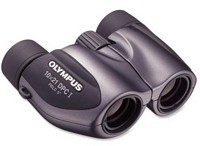 Olympus Roamer DPC (10 X 21mm, Start at $42) appeals to backpackers with their 6-ounce weight and compact size. Olympus Roamer DPC’s satisfactory optics is a great buy for value seekers who need binoculars for sporting events, opera shows and other short-medium range close-up viewing. Olympus claims that the special optical material used for the lenses can protect the eyes from harmful UV rays.
Olympus Roamer DPC (10 X 21mm, Start at $42) appeals to backpackers with their 6-ounce weight and compact size. Olympus Roamer DPC’s satisfactory optics is a great buy for value seekers who need binoculars for sporting events, opera shows and other short-medium range close-up viewing. Olympus claims that the special optical material used for the lenses can protect the eyes from harmful UV rays.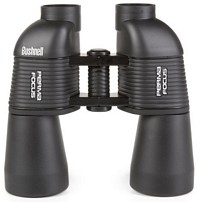 Bushnell PermaFocus Wide Angle Porro Prism Binoculars (7 X 50mm, Start at $49) brag about a wide field of view consisting of 578 feet from 1,000 yards away. The most appealing feature is the Permafocus that can zero in on anything more than 50 feet away without requiring any adjustment. This feature can be especially handy for keeping an eye on sports action or an animal on the move. However, this model is heavier than the others in its price range.
Bushnell PermaFocus Wide Angle Porro Prism Binoculars (7 X 50mm, Start at $49) brag about a wide field of view consisting of 578 feet from 1,000 yards away. The most appealing feature is the Permafocus that can zero in on anything more than 50 feet away without requiring any adjustment. This feature can be especially handy for keeping an eye on sports action or an animal on the move. However, this model is heavier than the others in its price range.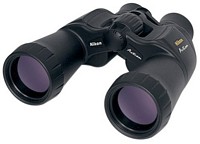 Nikon 7218 Action Binoculars (10 X 50mm, Start at $207) are perhaps the best binoculars that money can buy for an amateur user and a low-end for people seriously interested in bird-watching, star-gazing, and other recreational activities. Nikon’s aspheric technology offers a the particularly bright and sharp image. It’s wide angle design, a field of view of 446 feet at 1000 yards and a 12 foot-close focus range makes it an ideal medium-powered binoculars for back yard astronomy.
Nikon 7218 Action Binoculars (10 X 50mm, Start at $207) are perhaps the best binoculars that money can buy for an amateur user and a low-end for people seriously interested in bird-watching, star-gazing, and other recreational activities. Nikon’s aspheric technology offers a the particularly bright and sharp image. It’s wide angle design, a field of view of 446 feet at 1000 yards and a 12 foot-close focus range makes it an ideal medium-powered binoculars for back yard astronomy.
Traditional Recipe: Carrot Halwa or Carrot-Milk Concoction
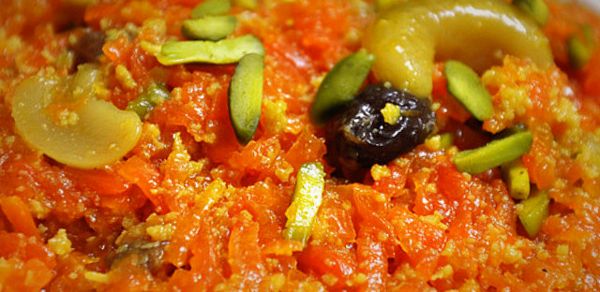
In the Indian tradition, women learn how to cook from their mothers and their mothers-in-law. Historically, women learned how to run a household and women in elite and upper middle-class families oversaw servants who did the cooking. Every home therefore has collections of interesting traditional recipes. The family’s recipes tell a story, the story of how people lived and cooked at a particular point in time.
The nuances in recipes tell about a family’s place in the social order, their enthusiasm for serving others food as they engage with others in their social class. In India, food can be anything from hunger-satisfier, hedonistic stimulation or merely an object of intellectual and social curiosity that delights the mind and body far from the family’s dining table with one overwhelming bite after another.
Carrot Halwa is a rich concoction of milk-boiled grated carrot and syrup flavoured with cardamom powder. It is a very popular dessert in several parts of India. Across India, the carrot halwa is a cultural phenomenon. Made with various practices and conventions, flavor preferences of carrot halwa is influenced by cultural factors. And these delightful tastes evolve over time with social intermingling and cross-breeding of cooking traditions.
Ingredients
- Carrot: 2 lb, finely grated
- 2% Milk: 1/2 of the volume of carrot
- Sugar: 1/2 of the volume of carrot
- Half-and-Half: 1/2 a cup
- Ghee (Clarified Butter): 5 tsp (can substitute with butter)
- Raisins: 5 tsp
- Cashew nuts, pistachios, almonds: 10 tsp (broken into small pieces)
- Cardamom powder: 1/2 tsp
Method
- Take a sauce pan and heat 2 teaspoons of ghee; fry raisins and cashew nuts on low heat until lightly roasted. Keep aside.
- In the same sauce pan, add grated carrot and milk and boil on a low flame until all the milk evaporates and the mixture looks dry. Keep the sauce pan open during this process; keep stirring regularly.
- Add sugar and half-and-half to the boiled carrot, keep stirring until all the sugar melts.
- Continue to stir regularly until about 80% of water in the sugar has evaporated.
- Add cardamom powder, the remainder of ghee and the roasted raisins and cashew nuts. Stir thoroughly and continue to evaporate the rest of the water in the mixture.
- When most of the water has evaporated, switch off the flame and stir. Do not allow the mixture to become hard. Remove the sauce pan from the stove, close the sauce pan and keep aside for 10 minutes.
- The carrot halwa is now ready. Serve it warm or chilled.
Notes
- Makes 5 servings
- Cooking time: about 75 minutes; slower the cooking, tastier the halwa.
- Adjust sugar based on preference.
- Grated carrot can be substituted with grated white pumpkin for another very popular dessert known as Kashi Halwa (named after the town of Kashi, a legendary city in the location of modern-day Varanasi and a prominant pilgrimage centre in India).
- To make Carrot Burfi, continue to heat the preparation on low flame. Take a plate and apply some ghee/oil to the surface of the plate and transfer the mixture on to the plate to prepare a fairly dense bed. After the halwa solidifies down, cut the bed into rhombus shaped blocks using a knife.